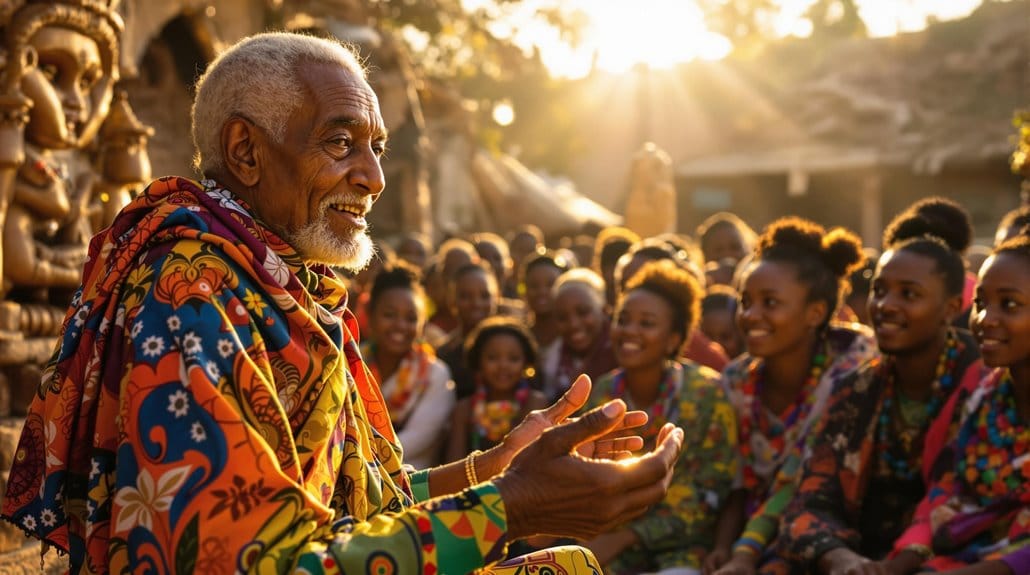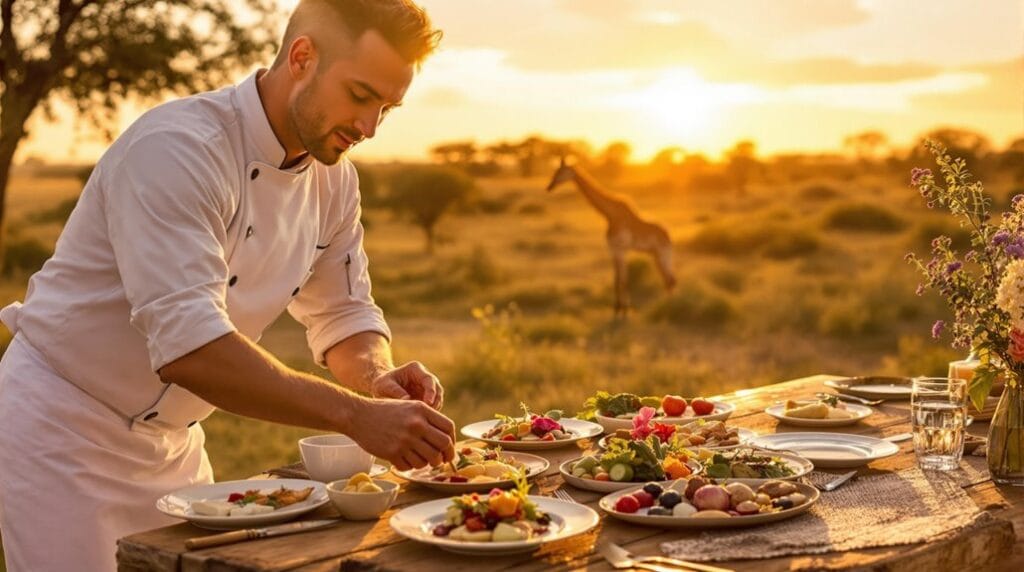You might not realize how deeply storytelling is woven into the fabric of African tribes, serving as a crucial link to history, identity, and community. These oral traditions aren't just entertainment; they're powerful tools for preserving customs and values across generations. Picture a vibrant gathering where a skilled griot captivates an audience with tales rich in symbolism and meaning. But what happens when these traditions face the pressures of modern life? Exploring the resilience and evolution of these practices reveals much more than you'd expect.
Key Takeaways
- Storytelling preserves African tribes' history, laws, and cultural values, ensuring continuity and identity across generations.
- Community gatherings, such as campfires and festivals, enhance storytelling experiences and foster intergenerational connections.
- The Griot tradition exemplifies oral heritage, with griots serving as custodians of history and cultural identity through musical performances.
- Storytelling promotes healing and resilience, offering spiritual guidance and empowering individuals to reclaim their identities through shared narratives.
- Praise singers elevate storytelling, celebrating cultural heritage while educating younger generations about their traditions and values.
Significance of Storytelling
While you may think of storytelling as mere entertainment, in African tribes, it's a cornerstone of cultural identity and continuity. Storytelling serves as an essential means of preserving history, laws, traditions, and cultural values, weaving the fabric of community life.
When you gather around a fire, you're not just listening to tales; you're engaging in a timeless ritual that connects you to your ancestors and the collective identity of your people.
In these vibrant communities, storytelling isn't a solitary act; it's a celebration of togetherness. With the help of imbongi, or praise singers, stories come alive through poetic expressions, reminding everyone of their rich heritage.
Each narrative shared can invoke ancestors, reinforcing bonds that bind the community.
Imagine participating in festivals, like the Re-imagined Storytelling Festival, where storytelling blossoms in contemporary society, allowing cultural exchange and the preservation of oral traditions.
You realize that these shared myths aren't just stories; they're lifelines that echo through generations, fostering understanding and belonging. In this way, storytelling transcends mere words, becoming a powerful tool for unity and healing within the community.
Communal Storytelling Events
Imagine gathering around a crackling campfire, the night air alive with the sound of traditional music, as the community comes together to share oral narratives that weave history, myths, and ancestral feats.
In these vibrant storytelling events, you're not just a listener; your participation transforms the atmosphere, fostering a deep connection between generations.
This rich tradition not only preserves cultural heritage but also ignites a sense of identity that binds the community together.
Importance of Oral Narratives
In the heart of many African communities, communal storytelling events serve as crucial conduits for cultural connection and reflection. Gathering around the fire, you'll feel the rhythm of traditional music played on indigenous instruments, enhancing the stories that unfold.
These events aren't just about listening; they invite your participation, transforming tales into a dynamic exchange that strengthens community bonds. As you engage with the stories and traditions shared, you'll discover a rich tapestry of history, myths, and ancestral achievements.
Each tale carries with it life lessons and moral values, beautifully imparted to younger generations. This vibrant oral tradition guarantees that cultural narratives are preserved, allowing you to feel a profound sense of belonging within your community.
These gatherings often take on a festival-like atmosphere, highlighting the importance of storytelling in maintaining cultural identity and heritage. You'll witness the respect and reflection that permeate the air, as everyone shares in the collective experience.
In this way, communal storytelling events become a crucial thread, weaving together the past and present, and guaranteeing that the essence of the community thrives.
Community Engagement Activities
Communal storytelling events pulse with life, drawing people of all ages into a shared experience that transcends time and space. These vibrant gatherings are more than just a form of entertainment; they're crucial community engagement activities that weave together oral histories, myths, and ancestral achievements.
As you join the circle, you'll feel the rhythm of traditional music and the warmth of shared laughter, creating an atmosphere ripe for connection and reflection.
Imbongi, the praise singers, elevate the storytelling experience, reminding everyone of their rich cultural heritage while celebrating esteemed historical figures through song and poetry. You'll find yourself captivated not only by the stories but also by the energy of the audience, whose participation reinforces community bonds and fosters a sense of belonging.
These storytelling sessions serve as critical educational platforms for younger generations. As you listen, you'll witness the transmission of history, laws, and traditions, ensuring that these indispensable narratives endure.
Engaging in this communal experience, you'll come to appreciate the power of storytelling—an art form that enriches lives and preserves the essence of African culture for years to come.
The Griot Tradition
The rich tapestry of African storytelling is vividly embodied in the griot tradition, a practice that dates back to the 13th century in the Mande empire of Mali. Griots serve as the custodians of history, weaving oral narratives that connect generations. Through their engaging tales, they preserve cultural traditions, ensuring that the stories of the past remain alive in the hearts of the community.
As members of an endogamous caste, griots marry within their community, reinforcing their unique cultural identity. Their performances aren't just storytelling; they're enriched by the melodic sounds of instruments like the kora, xalam, and ngoni, creating a multisensory experience that captivates audiences.
Griots hold a significant social status, often acting as advisors to royal families, which highlights their role as leaders and cultural ambassadors.
Becoming a griot involves years of rigorous training, emphasizing the importance of oral tradition. You'll find that each griot embodies the spirit of their ancestors, drawing from a well of knowledge that feeds the community's sense of belonging.
In a world that often feels fragmented, the griot tradition reminds you of the power of stories to unite and inspire.
Healing Through Stories
When you listen to the stories shared by a Sangoma, you're not just hearing tales; you're engaging with a profound spiritual guidance that connects you to your ancestors.
These narratives strengthen community bonds, weaving together personal and collective experiences that foster healing and resilience.
Through the power of storytelling, you discover a path towards holistic well-being, where every lesson learned becomes a step towards harmony and growth.
Spiritual Guidance Through Narratives
Stories hold a unique power in the healing traditions of African cultures, weaving together personal experiences and ancestral wisdom. When you sit with a Sangoma, you'll find that storytelling isn't just entertainment; it's an essential source of spiritual guidance.
Through narratives, you connect deeply with your spiritual beliefs, gaining insight into your life's challenges. Myths like the Tokoloshe serve as mirrors, reflecting your struggles and offering pathways to navigate negative influences.
These healing narratives are rich with moral lessons and cultural values, empowering you to reclaim your identity and foster resilience. As you hear tales of triumph and caution, you begin to understand that you're not alone; your ancestors stand beside you, offering protection and guidance.
The act of sharing these stories reinforces community ties, reminding you that healing is a collective journey. In this sacred space, you discover the transformative power of words, allowing them to illuminate your path.
Each narrative serves not only as a remedy for individual ailments but also as a bridge, linking you to the wisdom of those who came before, nurturing your spirit and fostering a sense of belonging.
Community Bonds in Healing
In countless African communities, storytelling acts as an essential thread that weaves individuals together, fostering deep connections during healing rituals. When a Sangoma tells a story, it's not just a tale; it's a poignant invocation of spiritual beliefs that facilitates healing and strengthens community bonds. Myths like the Tokoloshe serve as crucial lessons, reinforcing cultural values and morals while offering cautionary wisdom.
Through these healing narratives, the community invokes ancestors, creating an atmosphere of protection and guidance. This practice displaces negative influences, promoting psychological well-being and restoring harmony. As you listen, you'll feel the warmth of shared experiences, connecting you to those around you.
| Healing Aspect | Storytelling Role | Community Impact |
|---|---|---|
| Spiritual Invocation | Connecting with ancestors | Strengthening spiritual bonds |
| Moral Guidance | Reinforcing cultural values | Fostering belonging |
| Psychological Relief | Displacing negativity | Restoring harmony |
Storytelling in these rituals isn't just about healing; it's about preserving traditions and ensuring that the spirit of the community lives on through generations. You belong to this rich tapestry of culture and connection.
Oral Traditions in Crisis
The vibrant tapestry of African oral traditions faces an alarming crisis as digital media increasingly encroaches on cultural practices. You might notice how many younger villagers are unaware of the rich stories that shaped their identities, creating a disheartening gap in the transmission of these essential narratives.
The decline of traditional storytelling isn't just a loss of stories; it threatens the very essence of community bonds and cultural identity.
With the number of elderly storytellers dwindling, often leaving behind a legacy of wisdom in their 80s, you can feel the urgency to preserve these oral traditions in crisis. Festivals like the Re-imagined Storytelling Festival aim to reignite interest, showcasing the importance of storytelling in today's world.
They remind you that while modern issues can be woven into traditional tales, the overall erosion of these practices requires immediate attention.
As you engage with these narratives, consider the profound impact of oral traditions on your sense of belonging. Embracing and revitalizing these stories guarantees that the heart of African culture continues to beat, connecting generations and nurturing the community spirit that binds us all.
Contemporary Storytelling Practices
As contemporary storytelling practices evolve, they seamlessly intertwine traditional narratives with pressing societal issues, creating a dynamic platform for artists to express their realities. This fusion not only preserves cultural heritage but also addresses themes like war, materialism, and social justice, resonating deeply with today's audiences.
Consider these three aspects of contemporary storytelling practices:
- Multimedia Integration: Artists blend oral traditions with visual and digital elements, making stories more accessible and engaging to a wider audience.
- Cultural Festivals: Events like the Re-imagined Storytelling Festival in Nairobi foster community engagement, allowing diverse voices to share their narratives and strengthen cultural ties.
- Musical Enhancements: Incorporating instruments like the kora enriches storytelling performances, enchanting listeners and deepening their connection to the tales.
Through these practices, storytellers not only convey moral lessons and cultural significance but also invite you to reflect on your own experiences.
In this evolving landscape, you'll find a sense of belonging, as stories bridge the gap between the past and present, uniting communities through shared narratives and lived realities.
Symbolism in African Narratives
Symbolism weaves itself intricately through African narratives, enriching the stories with layers of meaning that resonate across generations. In tales like "Why chickens don't fly," you find a compelling exploration of squandered power and moral lessons that mirror daily life. The choice of colors and patterns amplifies this richness; red embodies life, while black symbolizes spiritual energy, deepening the narrative's significance.
Animals and natural elements often serve as the heart of these fables, each selected for its symbolic representation of human traits or societal values. This makes the stories relatable and offers moral guidance. For instance, a clever rabbit may represent cunning, reminding you of the importance of wit in overcoming challenges.
Moreover, the historical context within these narratives is essential. They often address themes of colonialism and identity erasure, providing a platform for communities to reclaim their heritage and assert their existence.
Through the use of metaphors and allegories, elders pass down wisdom, ensuring cultural identity thrives through shared symbols. In this way, symbolism not only enriches the narrative but also fosters a sense of belonging that bridges generations.
Festivals Celebrating Storytelling
While many cultures value storytelling, African festivals uniquely celebrate this ancient art, creating vibrant spaces where tradition thrives. You'll find events like the Re-imagined Storytelling Festival in Nairobi, which gathered diverse voices to showcase their rich traditions.
These festivals foster a sense of community and cultural exchange, drawing people together to share in the magic of narratives.
At these festivals, the atmosphere buzzes with excitement, offering opportunities for younger generations to learn and actively participate in oral traditions.
Here are three key elements that make these celebrations special:
- Artistic Expression: Festivals feature music, dance, and traditional instruments, enriching the storytelling experience and immersing you in the culture.
- Community Engagement: Audiences aren't just passive listeners; they contribute to the storytelling process, reinforcing cultural bonds and collective memory.
- Contemporary Reflection: Through traditional narratives, festivals address modern societal challenges, allowing you to reflect on history while engaging with present-day issues.
In this way, storytelling festivals become a crucial lifeline, connecting you to your roots and strengthening the fabric of community.
Cultural Impact of Storytelling
Storytelling weaves itself into the fabric of African cultures, playing a crucial role in shaping identities and preserving communal knowledge. It's a living tradition, where oral narratives serve as an essential means to pass down history, laws, and customs, ensuring that the wisdom of ancestors flows through generations.
As you gather around a fire, you'll feel the pulse of community engagement, where music and participation transform storytelling into a collective experience that binds everyone together.
The cultural impact of storytelling extends beyond mere entertainment. Praise singers, or imbongi, elevate these tales, bringing historical figures and cultural heritage to life, reminding you of your roots and shared values.
In healing practices, African Sangomas weave narratives to invoke ancestors, reinforcing bonds and providing spiritual solace. Festivals, like the Re-imagined Storytelling Festival, emphasize this impact by creating platforms for cultural exchange, allowing younger generations to connect with their heritage.
Through these vibrant experiences, storytelling nurtures a sense of belonging, deepening connections within communities and instilling pride in shared identities.
It's not just about stories; it's about the threads that unite you in a rich tapestry of culture and history.
Frequently Asked Questions
What Is the Storytelling Tradition in Africa?
In Africa, storytelling's a vibrant tradition, embodying cultural preservation. You'll find community gatherings where narratives unfold, blending history, morality, and music, creating bonds that celebrate shared identities and foster a sense of belonging among listeners.
Why Is Storytelling Important in Traditional African Society?
Imagine a world where every tale you hear shapes your very essence! In traditional African society, storytelling's essential for preserving cultural identity, weaving community bonds, and passing down wisdom that ignites belonging and strengthens shared heritage.
What Are the Techniques Used in African Storytelling?
In African storytelling, you'll find narrative techniques like vivid imagery, call-and-response interactions, and dynamic performances. These elements engage you deeply, creating a sense of belonging as you connect with shared cultural experiences and meaningful lessons.
Who Are Storytellers Who Pass on Traditions and Stories in Africa?
As night falls, you gather around flickering flames, listening intently. Griots emerge, weaving tales that breathe life into cultural preservation. Their voices echo history, teaching values and connecting generations, binding you to a rich, shared heritage.
Conclusion
In the vibrant tapestry of African tribes, storytelling serves as a sacred thread, stitching together the past, present, and future. Through communal gatherings, the rhythmic resonance of tales fosters connection and cultural continuity. The griots, with their melodic mastery, weave wisdom and wonder, promoting healing in hearts and homes. As you embrace these enchanting narratives, you join a journey of resilience, where the rich richness of heritage shines brightly, illuminating the path for generations to come.








